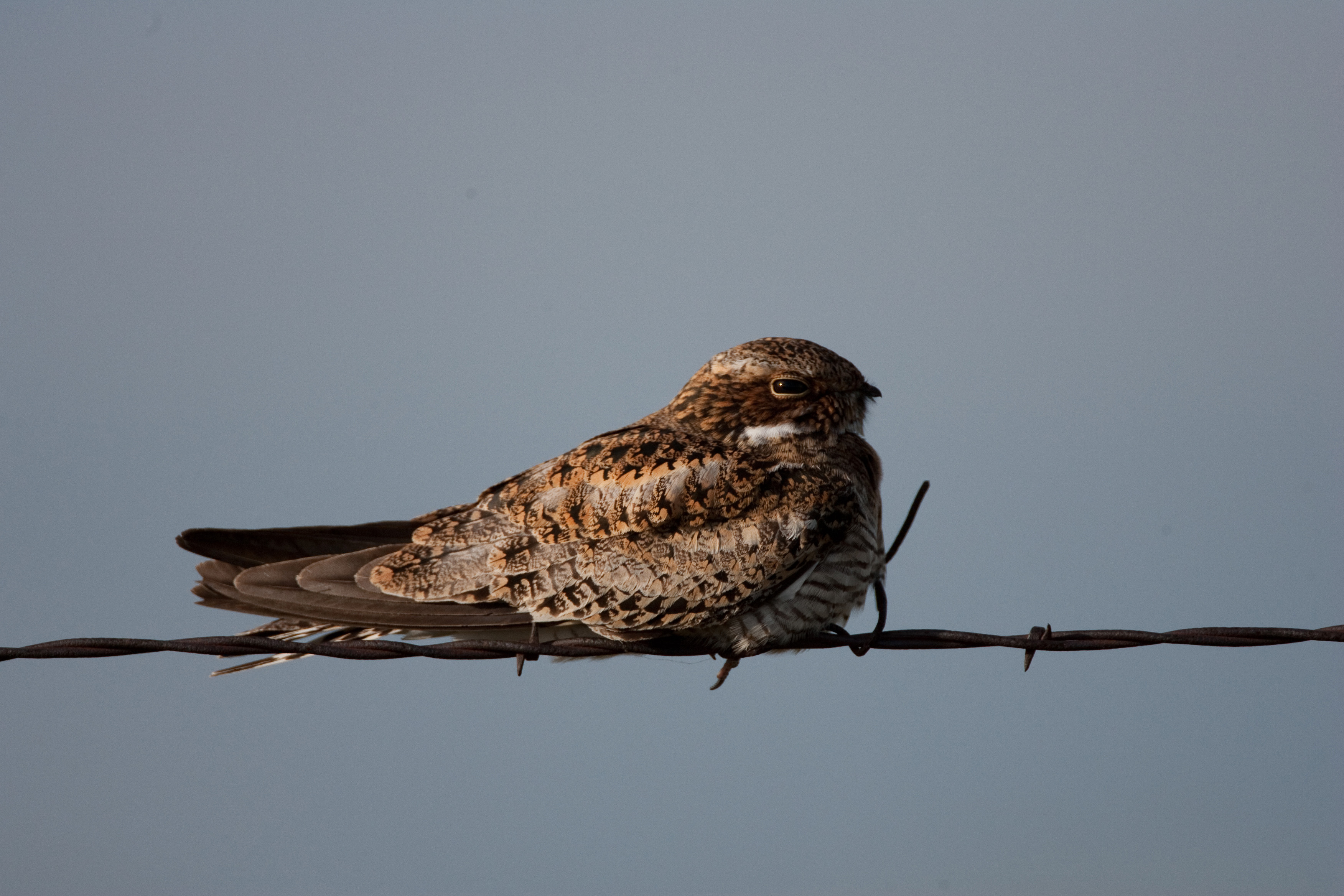HOME
Nighthawks

By Russell A. Graves
Cruising down a crunchy backroad just after sunrise, the dust from my tires drifts high in the air behind me. The wind is still and after a long, protracted span with little rain, the land is dry. Even at 8:30 a.m., the air is already stifling, and it’s going to be a hot day.
Up ahead, I see a familiar sight: sitting still atop a ragged and weathered cedar post is a nighthawk. Trying his best to stay camouflaged, the bird sits quietly atop the post. Its stippled coloration of blacks, grays and browns helps it blend into the post. If I weren’t specifically looking for this species of birds, I may have never seen it. It is one of those unique species that lives amongst us, but probably few ever notice it. I ease up next to it in my truck, kill the engine and proceed to press the button that brings my camera to life. A couple of dozen pictures later, I leave the bird behind and begin looking for more as summertime in Childress County is nighthawk season.
Beautiful yet mysterious, the nighthawk comes out to feed in the evenings and roosts during the day. Therefore, if you don’t know what you are looking for, you might just miss them even though they live amongst most all Texans. Scientifically speaking, the nighthawk isn’t really a hawk, but it belongs to a family of birds called nightjars. Nightjars are characterized by long, pointed wings, short legs and short bills. In Texas, species such as whip-poor-wills, poorwills, pauraque, and the common and lesser nighthawks are all part of the nightjar family. Also called goatsuckers, this family of birds was once thought to feed off the milk of goats.
While the nighthawk is a common bird, they are sometimes hard to find. Even though the common nighthawk is found over all of Texas and most of North America and the lesser nighthawk is found in southern Texas, they are still hard to casually observe. They are secretive, extremely well camouflaged and are mostly active at dusk and during the overnight hours.
To read more pick up a copy of the October 2017 NTFR issue. To subscribe call 940-872-5922.
HOME
Preparing Spring Gardens

By Hannah Claxton | Editor
The North Texas area is located within USDA Hardiness zones seven and eight. The zones are categorized by predicted low temperatures for winter and timing of the first and last frosts.
Zone seven usually has winter low temps between 0 and 10 degrees F with the average date of the first frost falling between Oct. 29 and Nov. 15 and the average date of the last frost falling between March 22 and April 3.
Overall, these two zones have similar climates and growing conditions, making the options for timing and variety within a garden very similar.
In these zones, cool-season crops should go in the ground in March, meaning that soil preparation should start now.
To read more, pick up a copy of the January edition of North Texas Farm & Ranch magazine, available digitally and in print. To subscribe by mail, call 940-872-5922.

HOME
Equine Vaccinations

By Heather Lloyd
Vaccinations are a critical component of maintaining the health and well-being of horses, especially in environments where they are exposed to other animals, such as in the sport, show and performance arenas. Horses, like all animals, are susceptible to various infectious diseases that can spread quickly and cause serious harm.
A routine vaccination schedule helps prevent the spread of these diseases by preparing the horse’s immune system.
To read more, pick up a copy of the November edition of North Texas Farm & Ranch magazine, available digitally and in print. To subscribe by mail, call 940-872-5922.

HOME
Wichita Falls Area Cattlewomen

Having herds on a controlled breeding schedule means that we have a predictable calving schedule, and while it’s only over a couple of months, for us it does fall right after the start of the year. I lobby annually to call ours the “Winter calving season”, but I am outvoted and my husband still refers to it as Spring. Unlike producers in our Northern States, we don’t have to contend with brutally harsh winter weather, and on those rare times we do, thankfully it is not for extended periods. Regardless of whether you have a Spring or a Fall calving schedule, the health of a newborn calf begins with the mother’s health, and the mother’s health is largely dependent on the producer.
To read more, pick up a copy of the November edition of North Texas Farm & Ranch magazine, available digitally and in print. To subscribe by mail, call 940-872-5922.

-

 Country Lifestyles2 years ago
Country Lifestyles2 years agoScott & Stacey Schumacher: A Growth Mindset
-

 Country Lifestyles8 years ago
Country Lifestyles8 years agoStyle Your Profile – What your style cowboy hat says about you and new trends in 2017
-

 HOME8 years ago
HOME8 years agoGrazing North Texas – Wilman Lovegrass
-

 Outdoor10 years ago
Outdoor10 years agoButtercup or Primrose?
-

 Country Lifestyles5 years ago
Country Lifestyles5 years agoAmber Crawford, Breakaway Roper
-

 Country Lifestyles9 years ago
Country Lifestyles9 years agoJune 2016 Profile – The man behind the mic: Bob Tallman
-

 Country Lifestyles8 years ago
Country Lifestyles8 years agoDecember 2016 Profile, Rusty Riddle – The Riddle Way
-

 Equine1 year ago
Equine1 year agoThe Will to Win




